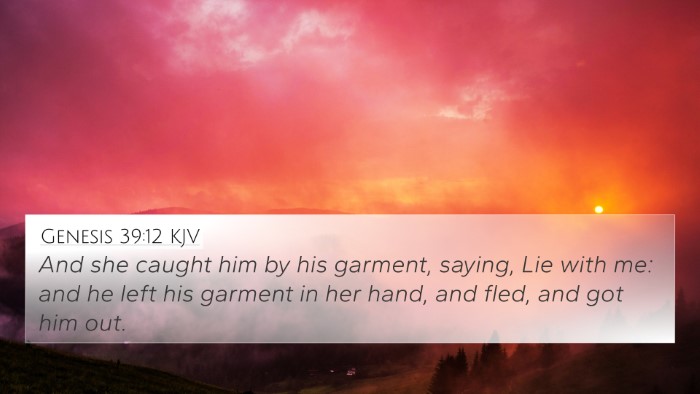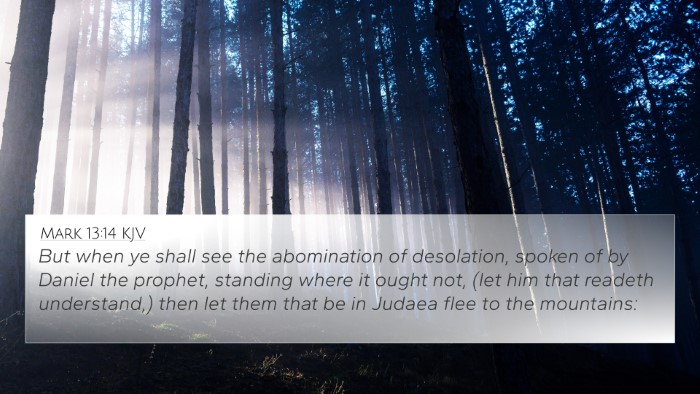Understanding Mark 14:52
Mark 14:52 states: "And he left the linen cloth, and fled from them naked." This verse is a part of the account of Jesus' arrest in Gethsemane and is notable for its brevity and stark imagery.
Context and Background
The passage occurs during the events leading to the crucifixion of Jesus. Just after Jesus is betrayed by Judas, a young man—often thought to be Mark himself based on early church tradition—fleeing from the scene, leaves behind a linen cloth. This moment captures the fear and chaos surrounding Jesus' arrest.
Commentary Insights
- Matthew Henry: Proposed that this young man represents the fear and abandonment that often accompanies moments of crisis. His fleeing starkly contrasts the courage expected of the disciples.
- Albert Barnes: Emphasized the symbolic nature of the young man's flight. It reflects the broader abandonment Jesus faced during his arrest, magnifying the isolation and vulnerability inherent in the Passion narrative.
- Adam Clarke: Suggested that the incident signifies the truthfulness of the Gospel accounts, hinting at a first-hand witness. The detail of fleeing naked exemplifies the desperation and turmoil of that night.
Themes and Connections
The flight of the young man serves several theological themes:
- Fear and Abandonment: This scene illustrates the fear experienced by Jesus' followers, as they abandon him in his time of need.
- Vulnerability of Christ: The nakedness of the fleeing young man represents the vulnerability that Jesus embodies during his trial and suffering.
- Witness and Testimony: The mention of a fleeing individual indicates someone who was present, providing an authentic human connection to the events of the trial and arrest.
Bible Verse Cross-References
This verse connects with various other biblical accounts and themes. Here are a few significant cross-references:
- Matthew 26:56: "But all this has taken place that the Scriptures of the prophets might be fulfilled. Then all the disciples left him and fled."
- John 18:10: "Then Simon Peter, having a sword, drew it and struck the high priest's servant and cut off his right ear. The servant's name was Malchus."
- 1 Corinthians 15:5: "And that he appeared to Cephas, then to the twelve."
- Luke 22:54: "Then they seized him and led him away, bringing him into the high priest's house. And Peter was following at a distance."
- Jeremiah 29:11: "For I know the plans I have for you, declares the Lord, plans for welfare and not for evil, to give you a future and a hope."
- Exodus 33:4: "When the people heard this disastrous word, they mourned, and no one put on his ornaments."
- Matthew 24:12: "And because lawlessness will be increased, the love of many will grow cold."
Scriptural Cross-Referencing
By examining Mark 14:52 alongside other scriptural passages, we can identify certain thematic and contextual dialogues:
- Fear: The theme of fear in Gethsemane connects to Peter's denials and the disciples' abandonment as noted in Matthew's and Luke's accounts.
- Isolation: The isolation experienced by Jesus parallels the prophetic cries in the Psalms where the righteous suffer alone.
- Witness: The unwanted attention and anxiety expressed through the young man's actions shed light on the deeper implications of discipleship and witness.
Comparative Bible Verse Analysis
This incident raises questions about the nature of discipleship and commitment as expressed in various gospels:
- In Luke 22:61, we see Peter’s heartbroken realization after denying Jesus, reflecting personal failure in the face of fear.
- Matthew 26:56 captures the abandonment of disciples as a collective experience, much like the individual nature of the flight in Mark.
- Husbands and wives are called to lay down their lives in love for one another, paralleling Jesus' example in laying down his life for humanity.
Tools for Bible Cross-Referencing
For those interested in delving deeper into cross-references, various tools and methodologies can enhance your study:
- Bible Concordance: A useful resource for finding specific terms and their occurrences throughout scripture, allowing for thematic exploration.
- Bible Cross-Reference Guide: Utilize guides to track similar concepts and verses across different books of the Bible.
- Cross-Referencing Bible Study: Employ study techniques that bring out thematic parallels and the interconnection of biblical texts.
Conclusion
Mark 14:52 serves not only as a pivotal moment in the Passion narrative but also as a window into understanding abandonment, fear, and vulnerability witnessed throughout the Gospel accounts. By interlinking various scriptures through careful analysis, believers can gain deeper insights into the implications of Jesus' arrest and the overall message of the Gospel.
As you study, remember to look for connections between Bible verses, using tools for Bible cross-referencing to enrich your understanding and reflection on the scriptural texts.





